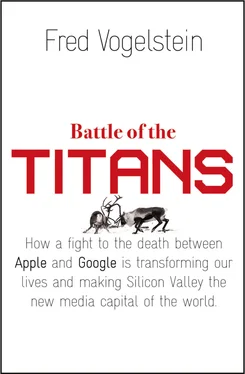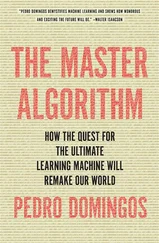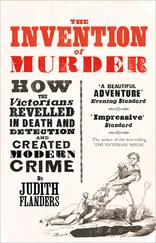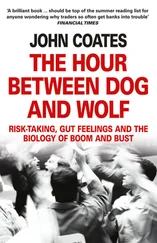“It quickly got really uncomfortable,” Grignon said. “Very rarely did I see him become completely unglued. It happened. But mostly he just looked at you and very directly said in a very loud and stern voice, ‘You are fucking up my company,’ or, ‘If we fail, it will be because of you.’ He was just very intense. And you would always feel an inch tall [when he was done chewing you out].” Grignon said that you would always ask yourself two questions during one of these lectures: “‘Is it my shit that broke this time?’ and ‘Is it the nth time it broke or the first time?’—because that actually mattered. The nth time would frustrate him, but by then he might have figured out a way around it. But if it was the first time, it added a whole new level of instability to the program.” Grignon, like everyone else at rehearsals, knew that if those glitches showed up during the real presentation, Jobs would not be blaming himself for the problems, he would come after people like Grignon. “It felt like we’d gone through the demo a hundred times and that each time something went wrong,” Grignon said. “It wasn’t a good feeling.”

The iPhone didn’t work right for a good reason; it wasn’t close to being finished. Jobs was showing off a prototype. He just didn’t want the public to know that. But the list of things that still needed to be done before the iPhone could be sold was enormous. A production line had yet to be set up. Only about a hundred iPhones even existed, all of them of varying degrees of quality. Some had noticeable gaps between the screen and the plastic edge, others had scuff marks on the screen. Thus no one in the public was allowed to touch an iPhone after Jobs unveiled it, despite a day of press briefings and a whole exhibit set up for them in the convention center. The worry was that even the best prototypes wouldn’t stand close scrutiny, Grignon said. They’d look fine at a distance and for Jobs’s demo, but if you held one in your hand, “You would laugh and say, ‘Wow, this thing really looks unfinished.’”
The phone’s software was in even worse shape. A big chunk of the previous four months had been consumed figuring out why the iPhone’s processor and its cell radio wouldn’t reliably communicate. This huge problem was akin to a car with an engine that occasionally doesn’t respond to the accelerator, or wheels that occasionally don’t respond to the brake pedal. “It almost brought the iPhone program to a halt,” Grignon said. “We had never seen a problem this complicated.” This was ordinarily not a problem for phone makers, but Apple’s obsession with secrecy had kept Samsung, the manufacturer of the phone’s processor, and Infineon, the maker of the phone’s cell radio, from working together until Apple, in desperation, flew teams of engineers from each company to Cupertino to help fix the problem.
Jobs rarely backed himself into corners like this. He was well-known as a master taskmaster, seeming to always know just how hard he could push his staff so that they delivered the impossible. But he always had a backup, a Plan B, that he could go to if his timetable was off. Six months prior he’d shown off Apple’s upcoming operating system, Leopard. But that was after letting the date for the final unveiling slip.
But Jobs had no choice 8but to show off the iPhone. He had given this opening keynote at every Macworld since he’d returned as Apple’s CEO in 1997, and because he gave public presentations only once or twice a year, he had conditioned Apple fans to expect big things from them. He’d introduced iTunes here, the iMac that looked like a fancy desk lamp, the Safari web browser, the Mac mini, and the iPod shuffle.
It wasn’t just his own 9company that Jobs had to worry about disappointing this time. AT&T was expecting Jobs to unveil the iPhone at Macworld too. In exchange for being the exclusive carrier of the iPhone in the United States, AT&T had given Jobs total control of the design, manufacture, and marketing of the iPhone. It had never done anything like this before. If Jobs didn’t launch on time, AT&T could back out of its deal. It’s not hard to explain that a product called the iPhone that couldn’t make calls would sell poorly. Days before, Jobs had flown to Las Vegas to give AT&T’s top mobile executives a limited demo of the iPhone. But they were expecting a full show at Macworld.
Lastly, the iPhone was truly the only cool new thing Apple was working on. The iPhone had been such an all-encompassing project at Apple that this time there was no backup plan. “It was Apple TV or the iPhone,” Grignon said. “And if he had gone to Macworld with just Apple TV [an experimental product back then], the world would have said, ‘What the hell was that?’”

The iPhone’s problems were manifest. It could play a section of a song or a video, but it couldn’t play an entire clip without crashing. It worked fine if you sent an email and then surfed the web. If you did those things in reverse, however, it did not. Hours of trial and error had helped the iPhone team develop what engineers called “the golden path,” a specific set of tasks, performed in a specific way and in a specific order, that made the phone look as if it worked.
But even when Jobs stayed on the golden path, it required all manner of last-minute work-arounds to make the iPhone functional. On announcement day the software that ran Grignon’s radios still had bugs. So too did the software that managed the iPhone’s memory. And no one knew whether the extra electronics Jobs had required to be added to the demo units would make these problems worse.
Jobs had required the demo phones he would use onstage to have their screens mirrored on the big screen behind him. To show a gadget on a big screen, most companies just point a video camera connected to a projector at the gadget. That was unacceptable to Jobs. The audience would see his finger on the iPhone screen, which would mar the look of his presentation. Instead, he had Apple engineers spend weeks fitting extra circuit boards attached to video cables onto the backs of the iPhones he would have onstage. The video cables then connected to the projector showing the iPhone image on the screen. When Jobs touched the iPhone’s calendar app icon, for example, his finger wouldn’t appear, but the image on the big screen would respond. The effect was magical. People in the audience felt as if they were holding an iPhone in their own hands. But making the setup work flawlessly given the iPhone’s other major problems seemed hard to justify at the time. “It was all just so monkey-patched together with some of the ugliest hacks you could imagine,” Grignon said.
The software in the iPhone’s Wi-Fi radio was so unstable that Grignon and his team ultimately soldered antenna wires to the demo phones and ran them offstage along the wires to the projection setup. The iPhone would still connect wirelessly to the network, but the signal wouldn’t have to travel as far. Even then, Grignon and his team needed to make sure no one in the audience could get on the frequency they were using. “Even if the base station’s ID was hidden [and therefore not showing up when laptops scanned for Wi-Fi signals], you had five thousand nerds in the audience. They would have figured out how to hack into the signal.” The solution, Grignon said, was simply to tweak the AirPort software to think it was operating in Japan instead of the United States. Japanese Wi-Fi uses some frequencies that are not permitted in the U.S.
There was even less they could do to make sure the phone call Jobs planned to make from the stage went through. All Grignon and his team could do was make sure the signal was good and pray. They had AT&T bring in a portable cell tower so they knew reception would be strong. Then, with Jobs’s support, they preprogrammed the phone’s display to always show five bars of signal strength regardless of the true signal. The chances of the radio’s crashing during the few minutes that Jobs would use it to make a call were small, but the chances of its crashing at some point during the ninety-minute presentation were high. “If the radio crashed and restarted, as we suspected it might, we didn’t want people in the audience to see that. So we just hard-coded it to always show five bars,” Grignon said.
Читать дальше













